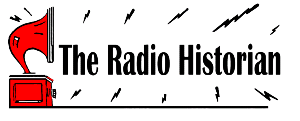|
www.theradiohistorian.org
Copyright 2017 -
John F. Schneider & Associates, LLC
[Return
to Home Page]
(Click
on photos to enlarge)
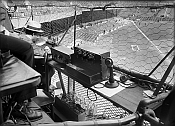
The broadcasting cage at Griffith
Stadium in Washington
DC in the early days of commercial radio, 1924. (Library of Congress)

Major
J. Edward White
calls an early sports broadcast for WJZ in New York.
His assistant, announcer Ted Husing (left),
would go on to become one of early radio’s best-known sports
announcers.
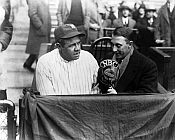
Graham
McNamee
interviews Babe Ruth in the bleachers during a Yankees broadcast.
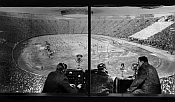
Graham McNamee and
George Hicks broadcast a Stanford University football game for NBC in
1935.
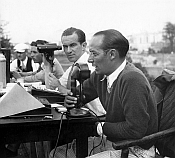
Ted Husing and Les
Quailey broadcast a game. Husing’s hand-held microphone was developed
especially to give him flexibility and freedom of movement while
broadcasting
sporting events.
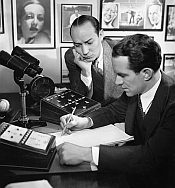
Quailey
and Husing
are seen here with the specialized spotter system they developed for
use during
football broadcasts.
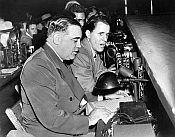
Don Dunphy (R)
broadcasts a boxing match in 1941 for the Mutual Radio Network. Bill
Corum (L) provides the color commentary between rounds.

Hal Totten broadcast
the Chicago Cubs games over WGN starting in 1924.
Here he gives a sports report on the NBC
network in 1935.
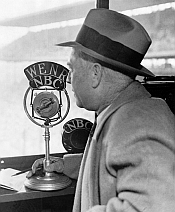
Tris Speaker
broadcast all the Chicago White Sox home games for NBC’s WENR in
Chicago, 1931.
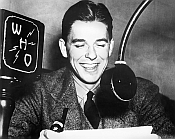
Ronald “Dutch” Reagan
began his public career as a popular sportscaster on WHO and WOC in
Iowa.

Early West Coast
sports broadcasters (L-R): Jack
Keough,
Don Thompson, Ernie Smith.
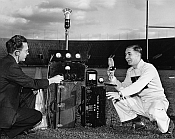
Play-by-play sports
broadcasting required specialized portable audio equipment, often
battery
operated. Here, the
Martin Shuler and
Newton Loken at WLB in Minneapolis (now KUOM) show off some of their
gear.
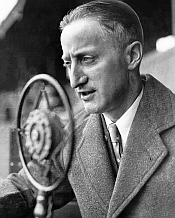
WWJ announcer Ty Tyson
called the Detroit
Tigers baseball games from 1927 to 1942.
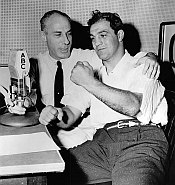
ABC sportscaster Bill
Stern with heavyweight boxing champion Rocky Marciano, 1955.
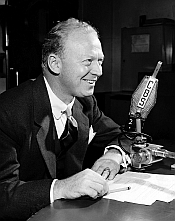
Red
Barber broadcast the Cincinnati Reds baseball games from
1934-39, the Brooklyn Dodgers from 1939-46, and the New York
Yankees from 1954-66. He was heard on NPR's "Morning Edition" from 1981
until his death in 1992.
|
|
From
its earliest days, radio broadcasting threatened to create a revolution
in news
reporting. It was
the first mass medium with
the capability of relaying an event to the public as it happened. When KDKA in Pittsburgh
broadcast the
Harding-Cox presidential election returns in November, 1920, it scooped
every
newspaper in the country by transmitting the returns as they were being
reported
from the precincts. Newspaper
readers
wouldn’t see the results until the morning after.
Despite
its great advantage of immediacy, radio did not become a dominant news
medium
until the start of World War II. Throughout
the 1920s and 30s, newspaper owners were successful in keeping the
press news
agencies from selling their services to broadcasters, and radio
remained a
secondary source for news. But,
the
reporting of sporting events was another story.
Sports and radio were a made for each other like
ball in glove, and the
country’s broadcasters were quick to capitalize on that advantage from
the
industry’s earliest years.
MORE
THAN SCORES
In
October, 1920, a month before KDKA’s famous broadcast, WWJ in Detroit
was
already broadcasting the final scores of the World Series games. But it was immediately
clear that audiences
wanted to hear details of the game’s progress, not just the final
scores. KDKA had a
solution to this dilemma on August
5, 1921, for a game between the Pittsburgh Pirates vs. Philadelphia
Phils
played at Forbes Field. They
sent a staff
member to sit in the top row of the bleachers near the outside fence. At the end of each inning,
he would drop a slip
of paper to a colleague waiting just outside the fence, and he would
race to a
pay phone to call in the game’s progress to the station. That fall, WLB,
the University of Minnesota’s
station, did them one better by forming a line of students to relay
notes from
the stadium to the studios during football games.
The
first known live play-by-play broadcast took place in October, 1921. All the Worlds Series
games were played in
New York City that year, as the Giants faced off against the Yankees,
and so KDKA
installed a wire line from Pittsburgh to the Polo Grounds in New York
and assigned
sportswriter Grantland Rice to broadcast the games live. The next month, KDKA
announcer Harold Arlin described
a Pittsburgh vs. West Virginia football game - the first live football
play-by-play broadcast.
BOXING MATCHES
Boxing
was also a huge sport in the 1921, and KDKA also broadcast the first
known boxing
match on April 11, when Florent Gibson broadcast a blow-by-blow
description of
the Johnny Ray vs. Johnny Dundee fight live from ringside. But the biggest fight of
that year was the
“Battle of the Century”, on July 2, 1921, when Jack Dempsey defeated
Georges
Carpentier for the heavyweight championship title.
RCA saw this fight as a great opportunity to
demonstrate the potential of radio with a live broadcast of the fight. For that purpose, it filed
a license
application for WJY, a one-time special-event station to be built for
the
express purpose of broadcasting the event from Boyles Thirty Acres in
Jersey
City. One of
radio’s earliest
celebrities, Major J. Andrew White, was picked to announce the game,
and a Navy
longwave rig (1600 meters, 187 kHz) was borrowed from the G.E.
transmitter assembly
line for the event. J.
Owen Smith, a New
York radio engineer and well-known ham operator, would operate the
transmitter.
The
project was beset with one obstacle after another.
The owner of the fight venue refused to allow
the transmitter to be located at the arena, and so it was installed
2-1/2 miles
away at the Delaware, Lackawanna and Western Railway terminal in
Hoboken. A mammoth
antenna was suspended between the
terminal’s clock tower and a radio tower on the property, and an
AT&T phone
line was installed to carry the broadcast from ringside to the
transmitter. But on
the day of the
broadcast, the AT&T engineers refused to connect the telephone
line to the
transmitter, in what was apparently a political dispute between
AT&T and
RCA. So
instead of a live broadcast of
White’s blow-by-blow description of the fight, listeners heard the
details of
the fight as described by engineer Smith, who heard White’s voice on a
phone
held up to his ear for the entire four-hour broadcast. If that wasn’t
stressful enough for Smith, a
transmitter tube suddenly overheated and burst during the last round of
the
match. He quickly
replaced the tube to
finish the broadcast, burning his hands so badly in the process that he
had went
to the hospital afterwards.
Despite
all these setbacks, the WJY project was considered a success. About 300,000 people were
estimated to have
heard the broadcast. Because
few people
had home radio receivers in 1921, most of the listeners paid to hear
the fight
over speakers mounted in theaters and bars around the Northeast. For many, it was their first
exposure to
radio, which would help feed the explosion in radio receiver sales the
next
year.
BASEBALL
RE-CREATIONS
Three
years later, Major J. Andrew White was again chosen by RCA to announce
the 1924
World Series over WJZ, which had opened a few months after the WJY
broadcast
and was one of New York’s biggest stations.
But this was to be a “re-creation” of the games
instead of a live
broadcast. In a game re-creation, the announcer sat comfortably in the
studio
and announced the game based on ticker-tape or Morse code descriptions
of each
play that were sent from the stadium.
White created the impression of a real play-by-play
broadcast for his
listeners, inventing imaginary details to fill in the gaps between the
raw
ticker-tape data.
Baseball
“re-creations” were not unusual in the early days of radio. Previously, announcer
Tommy Cowan had re-created
ball games for WJZ, and other stations, like WJAG in Norfolk, Nebraska,
and KQV
in Pittsburgh, had also adopted the technique.
The latter station went so far as adding the sound
effects of a cheering
crowd, band music, and the crack of the bat.
Sports re-creations, were a common practice at radio
stations around the
country into the 1940s, especially for away games where phone line
costs made
live broadcasting prohibitively expensive.
TED HUSING
Major
White was also tapped by WJZ for football broadcasts, and for a 1924
Penn-Cordell game, he brought along a young WJZ studio announcer to
assist
him. Ted Husing had
played some football
in college, and so was chosen to add some color commentary for the
broadcast. But when
it was time for the
broadcast, Husing was alone in the bleachers, with White nowhere to be
seen. Having no
other options, he started the
broadcast on his own and soldiered on until White finally arrived. His performance impressed
the station management,
and Husing’s career focus was soon changed to sports.
He excelled at describing live events due to his
sports knowledge, thorough preparations, fast-paced descriptions and
ample
vocabulary. Within
a few years, those
skills led him to be hired across town at the new CBS network in 1927,
where he
was their primary sports announcer until 1946.
For
his football broadcasts, Ted Husing’s assistant and right-hand man was
a man
named Les Quailey, who was possibly sports broadcasting’s first
“spotter”. Unlike
the leisurely sport of baseball, football
games sometimes moved swiftly, and it was a challenge to accurately
describe
the game. Husing and Quailey confronted this issue by inventing a
mechanical
annunciator, which they adapted from an apartment building’s electric
doorbell
system. In the stadium, while Husing was describing each play into the
microphone, Quailey observed the action through a special pair of
wide-angle
binoculars and identified the players involved in the action. When Quailey pushed the
appropriate button, the
players’ names would light up in ground glass windows on the device,
and they. It was an
invention created out of necessity,
and it helped to improve accuracy when describing a game.
GRAHAM McNAMEE
WJZ’s
biggest competitor in New York City was the AT&T station, WEAF,
and its
chief announcer was a young man named Graham McNamee.
For the 1923 World Series, WEAF hired a
newspaper sportswriter to call the game, and McNamee was chosen to
assist him
with the broadcast, giving him guidance on how to speak into a
microphone. McNamee
himself was not well-versed in
baseball, and it was felt that the veteran sportswriter’s deep
knowledge of the
game would make the broadcasts a success. But
baseball moves along slowly, and the
moments between the plays were filled with long periods of silence. Management became
increasingly frustrated
with the sportswriter’s dry and uninspired descriptions of the games. Finally, in the fourth
inning of the third
game, McNamee was asked to take over the microphone.
Although he lacked the sportswriter’s
knowledge of the sport, he possessed a keen talent for describing what
he observed
around him in great detail and with enthusiasm.
Between each play, he would describe the ambiance in
the stadium, the
weather, the activities of the players in the dugouts, those of the
fans in the
bleachers, and hundreds of other small details.
For the first time, an announcer was injecting
realism and excitement into
the game for an unseeing radio audience.
In 1924, announcing play-by-play sports was entirely
new, and McNamee
had no predecessors to copy - he was inventing the techniques of a
brand new
profession in real time. The
WEAF audience
loved his descriptions of the remaining series games, letters poured in
by the
thousands, and Graham McNamee was soon named by a listener poll to be
the
country’s most popular radio announcer.
In 1926, when RCA bought WEAF, brought it under the
same roof with WJZ
and formed the new NBC radio network, McNamee became its star announcer.
Barely
45 days into the life of the new NBC network, McNamee was assigned to
announce an
event that had never before been attempted - the country’s first live
coast-to-coast sports broadcast. NBC
leased over 4,000 miles of telephone lines to connect its more than 50
stations,
and on New Year’s Day, 1927, millions of radio fans heard McNamee’s
vivid
description of the Rose Bowl game from Pasadena, as Stanford and
Alabama fought
to a 7-7 tie.
After
the success of the Rose Bowl broadcast, McNamee was assigned to
announce dozens
more sporting events on both a national and international level. But, although he was a
skilled and popular
announcer, he had not played sports in school and so he lacked the deep
knowledge of sports that was becoming more essential.
So in 1928, to augment his rudimentary
knowledge of the game, NBC assigned an announcer from KFI in Los
Angeles to
assist him. He was
a former football
player from Colorado named Don Wilson.
That national exposure jump-started Wilson’s radio
career, and he went
on to become the announcer for Jack Benny’s radio and television
programs for
many decades. In
the meantime, McNamee
became NBC’s principal sports announcer, and he was tapped to announce
all of
the network’s World Series broadcasts through 1934. He also was
assigned many
of NBC’s plum news events, such as the national political party
conventions and
presidential inaugurations, and his voice was heard continuously on NBC
until
his sudden and untimely death in 1942.
He was posthumously inducted to both the National
Sportscasters and
Sportswriters and American Sportscasters Association Halls of Fame.
BILL STERN
In
the mid 1930’s, as McNamee gradually shifted his attention away from
sports
broadcasting in favor of emceeing several popular studio entertainment
programs,
the NBC sportscaster crown was passed to Bill Stern.
Hired in 1937 to host the Colgate Sports
Newsreel and Friday night boxing broadcasts, Stern was a fast-talking
announcer
with a commanding voice and a thorough knowledge of sports. He had become a successful
sports broadcaster
in spite of having lost his left leg in an automobile accident. Soon, Stern and Ted Husing
became fierce competitors,
working for rival networks, and the two broadcasters would often snipe
at each
other on the air. In
1939, NBC chose Stern
to call the first baseball and football games ever broadcast on
television. In
1942, when NBC was forced to divest of its
Blue Network and its name was changed to the ABC network, Stern’s
contract went
with the sale, and he remained a popular voice at ABC until 1956. Afterwards, he
was heard on the Mutual Radio
Network well into the sixties.
In
addition to the two big national networks, many local radio stations
adopted
sports as a key ingredient of their programming.
WGN in Chicago was one the most important of
these. In 1924, WGN
broadcast the
Indianapolis Speedway race, presenting the 7-hour program from a
specially-constructed soundproof booth.
The
same year, WGN broadcast live football games from every campus in the
Big Ten, as
well as Nebraska, Pennsylvania and Southern California.
In 1925, it broadcast the Kentucky Derby from
Louisville. All of
this represented a
huge investment by the station in leased telephone lines. Also starting in 1925, WGN
broadcast all home
games of the Chicago Cubs from Wrigley Field, with Hal Totten at the
microphone.
Meanwhile,
across town at WENR, the
Chicago NBC station, Tris Speaker was calling the games for the
American League
White Sox.
OTHER
NOTABLE
SPORTSCASTERS
There
were also dozens of early sports announcers who became regional stars
due to
the huge followings their broadcasts attracted. In
1924 in Detroit, WWJ announcer Ty Tyson
broadcast his first play-by-play event, a University of Michigan
football game. Then
in 1927 he called his first Detroit
Tigers game, and he continued doing the Tigers games over WWJ until
1942. In Iowa,
Ronald “Dutch” Reagan parlayed his
football experience at Eureka College into a sportscaster’s job at WHO
and WOC. He did
both live play-by-play broadcasts and
baseball re-creations. His
notoriety led
him to a career in motion pictures, and eventually to the presidency of
the
country. Meanwhile
over in Cincinnati, WLW
owner Powel Crosley purchased the Reds baseball team in 1934 and hired
Red Barber
to announce the games over his station.
Barber
had been broadcasting sports for four years, but had never attended a
major
league baseball game. Nonetheless,
he
called the first game he ever attended on WLW, and then continued as
the Reds announcer
for the next five seasons. In
1939, he
became the announcer for the Brooklyn Dodgers, and later succeeded Ted
Husing
at CBS in 1946.
During
the 1920’s and early 30’s, the West Coast had a separate radio world
cut off
from the rest of the country because of a lack of network phones lines
and the
time difference. Sports
broadcasting was
as important there as in the rest of the country, with college football
and
minor league baseball games being the most popular.
From San Francisco, which was the West’s
radio center at the time, announcers Jack Keough, Don Thompson, and
Ernie Smith
were heard regularly over the West Coast’s several regional networks.
The
sports announcer’s popularity was not limited to just baseball and
football. Announcer
Don Dunphy
specialized in the broadcasts of boxing matches, and he was heard on
radio and
television from 1939 to 1981. It
was
estimated that he called over 2,000 fights in his long career.
THE MODERN ERA
By
the 1950’s and 60’s, major league sports had become a big business, and
the
task of the play-by-play announcer was a highly specialized job. Some announcers became so
well identified
with the teams they broadcast that they were hired as employees of the
teams
instead of the stations, Dozens
of well-known
sportscasters come to mind from this period, including Russ Hodges,
Ernie
Harwell, Mel Allen, Jack Brickhouse, Harry Caray, Dizzy Dean.
Today,
sports broadcasting has developed into a highly complex and
commercialized art
form. We now have
hundreds of 24-hour all-sports
radio stations across the country, and there are more than seven ESPN
television
channels. Monday
Night Football attracts
twelve million viewers each week, and the Super Bowl sees more than 100
million
viewers each year. Thousands
are now
employed bringing major league sports into peoples’ living rooms and
automobiles. They
all have built careers
on the backs of White, McNamee, Husing, and the other forerunners who
invented
the art of sports broadcasting. They
pioneered
the art of describing a sporting event in real time to a mass audience,
and the
methods they created are still used today by thousands of modern
broadcasters. America’s
love of sports has spawned many billion-dollar
businesses, and they all owe a debt to the pioneer radio sportscasters
of the
1920’s and 30’s, who first brought live sports into American homes
across the
country.
PARTIAL BIBLIOGRAPHY:
- “The First Quarter Century pf
American
Broadcasting” by E.P.J. Shurick
- “You’re On The Air” by Graham
McNamee
- “My Eyes Are in My Heart” by Ted
Husing
- "Battle of the Century”, the WJY
Story”-
by Thomas H. White
- “Radio and its Impact on the Sports
World” by
Eric C. Covil
- “Raised on Radio” by
Gerald Nachman
NOTE:
This article appeared in the Spectrum Monitor Magazine, December, 2017
www.theradiohistorian.org
John F. Schneider & Associates, LLC
Copyright, 2017
|









